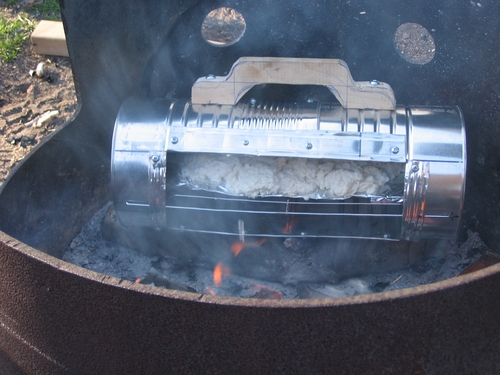Translations:AY Honors/Fire Building & Camp Cookery/Answer Key/83/en
Simmering
Simmering is a cooking technique where food is cooked in liquid that is almost hot enough to boil. Simmering allows the outdoor chef to cook foods longer to soften them without overcooking them and without using excess fuel. On a backpacking trip, this is especially important, as fuel is generally carried in the pack (and more fuel equals more weight).
Tough vegetables such as potatoes, carrots, turnips, and dried vegetables (such as beans and peas) are ideal candidates for simmering. Simply fill a pot with water (about half way), and add the vegetables. When the water begins to bubble, back off the heat (turn down a camp stove, or raise the pot higher over an open fire). Soup mixes are also ideal for simmering.
Boiling
Camping foods that are prepared by boiling include:
- Pasta (spaghetti, macaroni, etc.)
- Oatmeal
- Boiled eggs
- Cooked vegetables (carrots, green beans, corn, etc.)
An easy way to make corn on the cob is by putting the husked ears in a clean cooler, adding enough boiling water to cover it, and then closing the cooler. Let it sit for five or ten minutes. The corn will remain hot enough to prevent bacterial growth for half a day or more.
Frying
Foods that are prepared by frying include
- Pancakes
- Scrambled or fried eggs
- French toast
- Vegetarian sausages
- Veggie burgers
- Grilled cheese sandwiches
Bread on a stick
First you will need a bed of coals. If you attempt to bake your bread over a flame, it will be burned on the outside and raw on the inside. Make the bread dough or bring a frozen tube of pre-made dough. Get a straight stick 100-130cm![]() long and clean the end of it off. You can do this by removing the bark or by washing it in clean water. Wrap the dough in a thin layer around the stick, spiralling it as you go. The dough should cover the top 10-15cm
long and clean the end of it off. You can do this by removing the bark or by washing it in clean water. Wrap the dough in a thin layer around the stick, spiralling it as you go. The dough should cover the top 10-15cm![]() of the stick. Once the dough is secured to the stick, jam the other end of the stick into the ground or support it with rocks or large pieces of firewood, so that the bread is held over the coals. The bread dough should be held at a distance from the coals where it is uncomfortably hot to hold your hand. Turn the stick every couple of minutes until the outside is golden brown (this is why you need a straight stick). You can eat the bread right off the stick. This is an excellent early morning activity while everyone is trying to warm up around the fire. It works equally well at night.
of the stick. Once the dough is secured to the stick, jam the other end of the stick into the ground or support it with rocks or large pieces of firewood, so that the bread is held over the coals. The bread dough should be held at a distance from the coals where it is uncomfortably hot to hold your hand. Turn the stick every couple of minutes until the outside is golden brown (this is why you need a straight stick). You can eat the bread right off the stick. This is an excellent early morning activity while everyone is trying to warm up around the fire. It works equally well at night.
Aluminum foil baking
There are many foods that can be wrapped in foil and dropped into a bed of coals for cooking, but potatoes spring to mind immediately. Corn on the cob is also very good. Simply wrap them in foil, place them in a bed of coals, and take them out after a while. It's that easy.
A tasty dessert can be made by coring an apple, stuffing it with non-gelatinous marshmallows and a few pieces of cinnamon candy (such as Red Hots), wrapping it all in foil, and placing it in a bed of coals. Take it out after about 15 minutes and check that the marshmallow has melted. If it has, the apple is ready to eat.
You can also wrap vegetarian burger, thin slices of potato, carrot, and other veggies in foil. Add a tablespoon of olive oil, a pinch of salt (if desired), some pepper, and some garlic powder, seal, and place it in the coals. Check it after 30 minutes or so. When the potato is soft, it is ready to eat.
Reflector oven baking
A reflector oven is as simple as a cardboard box lined on the inside with aluminum foil. Run wire through the box to create an oven rack. Make sure the rack is horizontal when the box is placed on its side. Put the box next to a bed of hot coals with the opening facing the heat, but not so near as to ignite the box. Put whatever you wish to bake on the rack. Heat from the coals will bake whatever you put inside the box. There are countless variations on this theme, including the practice of completely removing one side of the box and tilting it at a 45° angle. You can prop the box up with rocks or logs, or build legs into it.
You can also construct an oven out of sheet metal, aluminum flashing, or large tin cans as shown below. This tin can oven was constructed by a Pathfinder leader, and tested by Pathfinders in the field.


